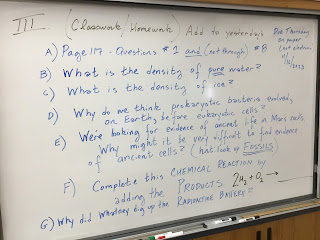Thursday, November 30, 2023
Wednesday, November 29, 2023
Tuesday, November 28, 2023
Monday, November 27, 2023
Friday, November 17, 2023
Wednesday, November 15, 2023
The note home: 11.15.2023
Hi Scientists;
This is meant for all classes - especially science. The overarching theme of this class is about protecting our BIOSPHERE, which took four billion years to evolve, in the face of a Mass Extinction. To that end we've been studying atoms, molecules, Earth systems, and engineering / physics before we settle down to focus on biology. Attached are board pics with today's notes and a pdf of the write up that can be found at www.pacificascience.org.November 15th - recap -
November - 2023 - “The Martian” -
Reviewing the first trimester and key concepts through the movie about a fictional astronaut stranded on Mars.
Key Terms and important concepts are CAPITALIZED.
Environmental Science / Science connection: In both classes we addressed the fact that our Earth is experiencing a sixth MASS EXTINCTION. Extinctions, due to human activity, are caused by habitat destruction, invasive species, and pollution which causes environmental degradation.
As an example, this teacher saw a dead mountain lion on highway 280 last week. While her two cubs were rescued (they are going to the Oakland Zoo) it’s an example of the habitat reduction that forces animals to forage in smaller, disconnected areas.
Atoms and molecules: We began our studies (this school year) with the, roughly, one hundred elements that we list on the PERIODIC TABLE. Some ISOTOPES of ELEMENTS are unstable and fall apart or DECAY. This is important for dating fossils in biology, as part of studying EVOLUTION and, in “The Martian”, Mark Watney - our fictional astronaut - used a battery, powered by a radioactive element, to keep warm while traveling around Mars.
RADIOACTIVE DECAY is also important for keeping Earth hot inside! This drives PLATE TECTONICS and helps with recycling materials essential for LIFE while, also, constantly changing the oceans and landscape.
This leads to another, important, difference between Mars and Earth. The atmosphere of Mars is far less DENSE that the atmosphere of Earth. Also, it is composed, mostly, of CARBON DIOXIDE, while Earth’s atmosphere has, about, twenty percent OXYGEN and eighty percent NITROGEN. Earth has free OXYGEN thanks to PHOTOSYNTHESIS. Mars, being much less massive than Earth, has lost much of its water and atmosphere.
This connects to one of the FOUR FUNDAMENTAL FORCES of nature; GRAVITY. Gravity is proportional to MASS. In other words, more mass means more gravity. The fictional space ship; “Hermes”, in - “The Martian” - spins to create “artificial gravity” as a very long space mission - like a mission to Mars - would be too difficult on the human body without simulated gravity. The human heart becomes weaker in microgravity and muscles lose mass and bones decrease in density.
Since the strength of GRAVITY decreases with distance, Mars orbits our Sun slower than Earth orbits our sun. This means that Earth overtakes Mars in orbit and there are only specific times when both Earth and Mars are aligned so that a launch can occur. This is another reason why launching spaceships with people to Mars is much more difficult than launching spaceships to our moon. Our moon is much closer than Mars and the distance does not vary much.
The SPEED OF LIGHT comes into play as communication with mars has a significant delay. As light speed is a constant it can take between five and twenty minutes for a signal to travel one way! (Remember the spectrum; radio waves are just another form of light in the ELECTROMAGNETIC SPECTRUM. Some of the other forms of light are Ultra Violet, Gamma Rays, X-Rays, Infra-red, and Microwaves.) Mars had no protective OZONE or significant MAGNETIC FIELD, so exposed life on mars would be quickly frozen then fried!
The concept of DENSITY is particularly important when discussing WATER. Water is a POLAR molecule and the solid form of WATER, (ICE). ICE is less dense than liquid water. This important characteristic of water is part of what makes water critical for LIFE. Water is the UNIVERSAL SOLVENT and Earth exists in a “Goldilocks zone” where water exists as a SOLID, LIQUID, and GAS.
While studying the RUSTED rocks of Mars our rovers have looked for signs of ancient life. Ancient life would, likely, resemble PROKARYOTIC life on Earth. BACTERIA - cells without a nucleus or other organelles - as we think that BACTERIA was the first life that EVOLVED on Earth. EUKARYOTIC cells (cells with organelles) - evolved after bacteria. In both cases, cells leave very little evidence in the form of FOSSILS when they die.
The rocks and minerals on Mars compose the DIRT that Whatney needs to grow PLANTS. However, he must add BACTERIA in an attempt to create SOIL. Soil is a living ECOSYSTEM of organisms living in SYMBIOSIS.
In terms of PHYSICS - The fuel required to travel to Mars means that the Hermes crew - once they realized Watney was alive on Mars and in need of rescue - could not, simply, “turn around” and go back and help him. NEWTON’S FIRST LAW illustrates how the ship’s momentum was carrying it towards Earth and there was not, nearly, enough fuel to turn around. A lack of FRICTION, in space, means there would be nothing to slow down the Hermes. In the last scenes of the movie there is an excellent example of the crew using NEWTON’S SECOND LAW to slow the ship.
I hope you enjoyed the showing of “The Martian” and I hope it increased your appreciation for the amazing combination of events that make life possible on Earth and the importance of preserving the only BIOSPHERE known in the UNIVERSE!






























